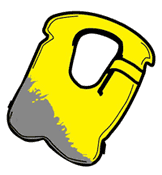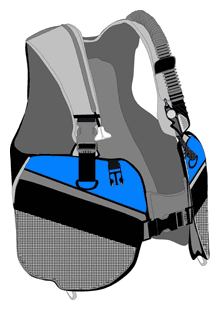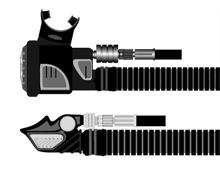BCD (Buoyancy Compensating Device) or Buoyancy Compensator (BC)
In the 1950s, as cave divers began adding more and more equipment to extend their bottom times, a problem emerged: add together two steel tanks, a light with an external battery, some line reels and the various other paraphernalia need to safely explore caves, and the combined weight is enough to pull a diver to the bottom. That’s not desirable, particularly when the bottom is made up of two feet of silt.
So cave divers, being naturally clever people, came up with a solution. They added two empty “jerry can” fuel cans to their equipment, hooked the cans to their dive harnesses, and judiciously added air to the cans from their regulators until the cans were buoyant enough to allow them to hover clear of the bottom.
Voila – the buoyancy compensating device, better known as a “buoyancy compensator,” or a “BC” – was born.
Today, metal and plastic fuel cans have given way to tough, abrasion-resistant air bladders, sometimes worn on the back between a diving harness and a scuba tank, but more often incorporated into a vest-like “jacket style” BC that has straps to hold a scuba cylinder built right into it. And some BCs even have quick-release weight pockets built right into them, eliminating the need for a separate weight belt, and giving divers everything they need to perfectly fine-tune their hovering ability in one package.
How a BC Works
Imagine that you have a pair of two-liter soda bottles, one filled with steel ball bearings and the other filled with Styrofoam. Put them in water, and the one full of ball bearings will sink, while the one filled with foam will float.
Why? Most people will answer, “Because there’s air in the foam.” But there’s air in a scuba tank, too, and most scuba tanks, when full, will sink.
The real reason things sink or float has to do with how much they weigh, compared to something else of the same size and shape filled with water. If an object is heavier than the water it displaces, it will sink. If it’s lighter, it will float.
To apply this to a person, consider this: an extremely muscular and athletic person might naturally sink in water, even without any scuba gear on at all. Put that person in a BC without any air in it, and he or she will probably still sink. But add a bit of air to that BC, and that entire unit – the person and the equipment – becomes marginally larger, without any appreciable increase in weight. In very short order, the diver weighs less than the volume of water that he or she is displacing. As soon as that happens, they float!
BCs become even more important when divers use closed-cell foam neoprene wetsuits, which are buoyant at the surface. As divers go deeper, the little nitrogen-filled cells in the neoprene foam are pressed smaller and smaller by the water pressure, and the suit becomes less buoyant. So a suit that may have required the diver to add ten pounds of weight at the surface in order to submerge will probably not have enough “float” to keep the diver from sinking once he or she is 30 or 60 feet underwater. Add a touch of air from the scuba tank (there is a special hose and a button that lets you do this) and the ability to hover is regained. When the diver goes up, he or she releases air to offset the extra buoyancy as the wetsuit cells expand again. Many BCs have more than one means of doing this.
A good BC does more than just keep you off the bottom. It also allows you to maintain depth without kicking, and lets you swim in a horizontal, rather than angled, position. Less kicking means less energy required, and less air consumed. And swimming horizontally helps you stay as streamlined as possible – which again consumes less energy … and less air. So a good BC, used well, can literally mean the difference between a 20-minute dive and a one-hour dive.
There’s another benefit; when the diver gets back to the surface, the BC can be inflated to keep the diver relaxed and afloat while working back to the boat or the shore. And the BC can assist at the surface in carrying objects such as those cool treasures you’re going to find while diving. With this in mind, you will often hear discussions of how much “lift” a particular BC has. This is a reference to how much weight it can support when fully inflated.
Which Kind is Best?
While the old adage, “you get what you pay for” is true in most things in life, it’s worth noting that price is not necessarily an indicator of the level of diving for which a BC is intended. Deep, technical shipwreck divers often opt for a BC design that is one of the simplest – and therefore often costs less than some designs used for general recreational diving.
As with most dive gear, different types of BCs are preferred for different types of diving. A weight- and space-conscious traveling diver may be willing to go without some features in order to have a BC that folds and packs compactly and adds little to the weight of a gear bag. A diver using tools such as line reels and work slates during a dive may want a BC that puts most of the flotation in back, between the diver and the tank, and leaves the front of the BC open for attaching those tools. A diver instructor who spends much of her day floating at the surface and talking with her class may prefer a BC that moves some of that flotation to the front, so she can effortlessly float upright on the surface between dives. And divers wearing drysuits (to which air is also added during a dive) will look for BC styles that work harmoniously with the drysuit’s design, and the buoyancy provided by the suit.
All BCs must do two things. When fully inflated, they must be capable of comfortably floating the diver, with all of his or her gear for the dive at hand, at the surface, with no other assistance. And they must fit well, with all releases and controls easy to reach. Beyond that, it’s simply a matter of matching the BC to the diving you want to do. To do that, just talk with the staff at your local professional dive center; they’re trained to help you find the perfect BC for your diving.
Types of BCs
 The first BCs designed for recreational divers were based fairly closely on the inflatable personal flotation devices used by pilots and military aircrews. These were later refined into what was known as a horse collar BC, which placed most of the flotation on the diver’s chest and behind the diver’s neck.
The first BCs designed for recreational divers were based fairly closely on the inflatable personal flotation devices used by pilots and military aircrews. These were later refined into what was known as a horse collar BC, which placed most of the flotation on the diver’s chest and behind the diver’s neck.
The good news was that this tended to float the diver face-up – a desirable attribute if an exhausted or injured diver had to be taken to the surface.
The bad news was that this sort of BC also tended to roll the diver face-up under water. Learning how to ride the bubble of buoyancy on one’s chest was a skill easily acquired, but it was not effortless. So gear designers began looking for a different approach.
In the 1970s, they came up with the jacket-style BC, also known in some regions as a stabilizing jacket or stab jacket: a BC in which the cells providing the buoyancy completely surrounded the diver’s torso. This made it possible for the diver to still float upright at the surface, but it made swimming underwater a much more intuitive process. Because of this “win/win” approach, jacket-style BCs quickly became, and still remain, the most popular style of BCs with general recreational scuba divers.
A variation on the jacket style is the front adjustable BC. These have become very popular at resorts because they provide the ability to make adjustments and to fine-tune the fit of the BC with the diver. A diver wearing a large BC can “snug” the adjustable BC so that it stays comfortable in the water and doesn’t wobble as the diver swims underwater.

A style of BC that makes hovering horizontally almost completely effortless is the back floatation BC. In this design, the BC’s air bladder is worn on a harness and sandwiched between the diver and his or her tanks. Because such a BC allows you to “trim out” horizontally so easily, it tends to be very popular with divers who operate in confined spaces, such as shipwrecks or caverns and caves. Also, because this type of BC does not squeeze in on the diver as it is inflated, it tends to work really well with drysuits, which must have room for air movement in order to work optimally. Since this type of BC doesn’t necessarily float an unconscious diver face-up at the surface, it tends to be used more by experienced divers who are experienced in distributing the weight of their equipment, and by divers who wear steel tanks (which weigh more and help balance out the weight of the diver on the other side of the BC).
Both of these basic types of BCs are available as travel BCs, which are designed to fold and store more compactly than conventional BCs.
Both are often available in weight integrated forms, which do away with the need to wear a weight belt to offset the natural buoyancy of most wetsuits and drysuits. With a weight-integrated BC, the weight is carried in specially designed pockets that allow the diver to “ditch” (or drop) the weights in an instant if necessary.
And as a reflection of the growing number of women diving, women’s BCs are now available from many manufacturers. These are anatomically cut and styled to fit women more comfortably.
A number of other features and options are available on today’s BCs. On some, the low pressure inflatorused to add air from the tank can also be used as a back-up regulator. Many newer BCs incorporate features to help streamline the diver and reduce or eliminate dangling items of gear. And because image is important, even when you’re underwater, many BCs are available in colors (and even prints) designed to complement the rest of your gear.

When to Buy
Because the two pieces of gear work so closely together, most people buy their first BC at the same time that they buy their first regulator set. If you’re pretty certain what sort of diving you’re going to be doing, this might be before you’ve started your open-water class, so you can practice with your own gear and get accustomed to it in the class. Or if you’re still uncertain what sort of diving you most enjoy, you might want to ask your dive instructor and your professional dive center and then buy your BC.
How to Buy
Because fit is so important with a BC, see if you can try the BC on with the sort of suit that you will be wearing for your diving. If you’re planning on using more than one suit, try the BC on with the bulkiest suit you intend to dive in, and ask your dive instructor or dive center professionals to help you assess the fit. You want a BC on which you can reach all the controls and releases easily, without stretching or straining.
If you have a scuba cylinder (tank) on when you try the BC, it will probably hang a little low in back and pull the BC back on your shoulders – don’t be concerned about this, because the tank and BC will ride in a much more natural position when you’re in the water. In the store, how the BC hangs without a tank is a much better indication of how it will ride when you’re using it in the water.
BC Maintenance
BCs should be rinsed in clean, fresh water at the end of each day of diving, and the air bladder should be drained of any water that has entered it during the dive, and then well rinsed with clean, potable water as well. When you store a BC, the interior of the air bladder should be dry, and you want to store it with enough air in the BC to keep the sides of the bladder from sticking to one another. For longest life it’s best to store a BC away from heat and ozone sources (such as furnaces and water heaters) and away from direct sunlight.